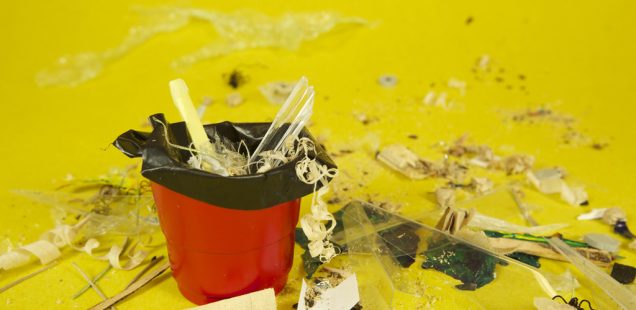
Party in the Front, Business in the Back
Party in the Front, Business in the Back is an ongoing series of lenticular digital images that can help us envision new temporal possibilities for professional artistic disaster.
The images in Party in the Front, Business in the Back use a combination of 1/12-scale miniatures inexpertly constructed from wood and paper, toys (erasers, play-doh, plastic spiders), and other small objects (rubber bands, pencils, dice). All of them to, to one extent of another, depict “artistic disastersâ€: things going wrong or flying of control, of just being not quite right. Many are deliberately ambiguous, making use of associative contrast and connotation to leave viewers enchanted but uneasy.
Lenticular images use a transparent plastic film comprised of hundreds of narrow cylindrical lenses (“lenticulesâ€). The lenses refract a different offset image to each eye, which tricks the brain into thinking an image is three-dimensional. Widely used in children’s toys, religious iconography, and vintage porn, lenticular printing implicates the audience by demanding a present viewer’s binocular eyesight to become fully visible. Lenticular prints are a sandwich: a digital print on DisplayTrans backlight media, a layer of optically clear adhesive, and the lens sheet on top, precisely aligned. The photo in back in printed in stripes – one stripe of each image under each lens. My lenticular sheet is 30 lenses per inch, so prints with two images have 60 stripes per inch. (Prints with three base images would have 90 stripes per inch, and so on.) I’m excited by their possibilities for storytelling that use embodied vision to create an ambiguous temporality – one that disrupts the clear vision on which it depends.
Lenticulars expose viewers’ subjectivity by demanding our present bodies with two eyes. These images’ resolution is an illusion produced by my body and its specific position. Their grainy images, even when fully resolved, hold the promise of transforming into something else with the slightest movement. If, physically and textually, the images move, they move temporally as well. Party in the Front’s unstable images are located simultaneously in the past, present, and future. They are haunted by the ghosts of what they are not, of what they might become, and of what they are about to become. They flicker, unstable. Initially composed of two images, the prints become more than two: a physical, visual, and temporal array. Instead of merely reconciling opposites (each defined by what they are not), the image binaries have become inextricably conjoined.
Party in the Front extends my practice’s giddy-but-ambivalent illumination of artists and art institutions behind-the-scenes. This work, with its physically and temporally unstable images (and viewers), might be interpreted, in part, as an attempt to illustrate my own anxieties about economic and professional precarity, as we humans hurdle into the future.








Comments are closed, but trackbacks and pingbacks are open.